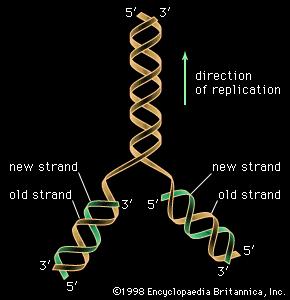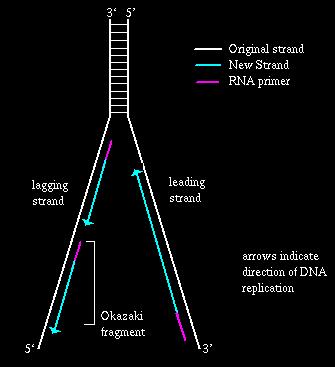
Two representations of how DNA replicates - the above image is very simple, the image below distinguishes between the lagging strand and the leading strand

DNA replication
Watson and Crick proposed that DNA replicated by splitting into two strands, and where the base pairs provide a method of stabalisation in the double helix shape, they also provide a means for the DNA molecule to be replicated exactly in cell division. In the following paragraph is a very brief overview of how the replication occurs.
First of all the double helix unwinds. This is initiated by enzymes, known as helicases, which move along the DNA molecule. There are then two strands of DNA. One of these is the leading strand, and the other is termed the lagging strand. In the leading strand, another enzyme, called DNA polymerase, moves along the strand in the same direction as the helicase, and adds the corresponding base to the new strand which is being built, along with the phosphate and sugar group. The process is slightly more complicated than for the lagging strand. Following unwinding, primase (an enzyme) moves along the DNA strand and synthesises a short RNA primer, which is around 100 to 200 nucleotides in length, which contains RNA bases. Each of these segments of RNA nucleotides is called an Okazaki fragment, after the Japanese scientist who discovered them. Another DNA polymerase replaces the RNA nucleotides in the Okazaki fragment with the corresponding DNA nucleotides. The individual DNA fragments are then joined together by an enzyme called DNA ligase. The process of replication along the lagging strand moves away from the replication fork, the place where the double-helix is separating, hence it occurs as a discontinuos process, whereas the replication along the leading strand, which moves in the opposite direction, occurs as a continuos process, and requires only one enzyme to occur.
 |
|
Two representations of how DNA replicates - the above image is very simple, the image below distinguishes between the lagging strand and the leading strand
|
 |
The reason for a leading strand and a lagging strand is that the enzyme DNA polymerase can only add nucleotides to the 3' strand. Therefore, to replicate the 5' strand, other enzymes are required to hold the appropriate nucleotides in the correct place on the chain, and then DNA polymerise moves along the chain linking the nucleotides together.
This process of replication ensures that the genetic code, which is contained in the DNA, stays intact, as each new strand of DNA is made up of half the old one.
DNA replication in human cells occurs at a rate of about 50 nucleotides per second being added to the new chain, and this is done extremely accurately, with an an error accuring only about once in every billion (1,000,000,000!!) nucleotides linked - that's an accuracy of 99.9999999%!